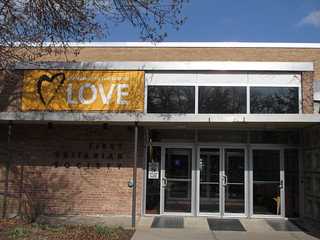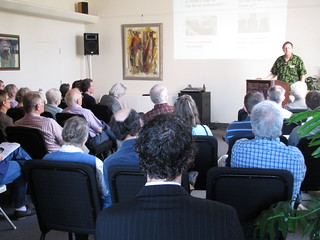The First Unitarian Society of Minneapolis recently won the EPA ENERGY STAR Battle of the Buildings competition in the House of Worship category, competing against 245 other buildings to reduce their energy use. The congregation has saved over $16,000 in the first year almost entirely from no-cost and low-cost opportunities.
Nearly 50 people representing congregations and organizations across the Metro region gathered at the First Unitarian Society in Minneapolis on Sunday, March 18th to tour the energy efficiency improvements that have been made to that building. The event was organized by Metro CERT in partnership with Minnesota Interfaith Power and Light and the First Unitarian Society Green Team.
Metro CERT convened this event as an opportunity to highlight the success of First Unitarian Society’s energy efficiency and conservation efforts, and to share tips and ideas with other congregations who are interested in following suit. Minnesota Interfaith Power & Light believes the active care of creation is integral to spiritual life and social justice. Through leadership and guidance to Minnesota’s faith communities, they assist congregations in responding to climate change by promoting energy conservation, energy efficiency, and renewable energy sources.
 The First Unitarian Society (FUS) church building was built in the 1950s, during the peak of inefficiency in design. However, FUS Board of Trustees member Madalyn Cioci urged audience members not to let having an inefficient building stop them from taking action. ”The greenest building is one that’s already built,” said Cioci, “and that is made as efficient as possible.” Most of the savings achieved at FUS were the result of simple, low-cost repairs and improvements.
The First Unitarian Society (FUS) church building was built in the 1950s, during the peak of inefficiency in design. However, FUS Board of Trustees member Madalyn Cioci urged audience members not to let having an inefficient building stop them from taking action. ”The greenest building is one that’s already built,” said Cioci, “and that is made as efficient as possible.” Most of the savings achieved at FUS were the result of simple, low-cost repairs and improvements.
First Unitarian Society member and Division of Energy Resources staff person Bruce Nelson got the process started by benchmarking the church’s current energy usage, to determine how they compared to other buildings. At the event Nelson stressed the importance of benchmarking, as a way to compare your building to others of similar size and age. This building benchmark, given in kBTU/square foot/year, is like a miles per gallon rating for your building.
When the project began FUS’ building had an Environmental Protection Agency ENERGY STAR Portfolio Manager score of 29 (meaning that 71% of similar buildings were more efficient than FUS). Since beginning their energy efficiency and conservation efforts, FUS has increased its score by 30 points! They are now at 59, and a score of 75 will qualify them as an ENERGY STAR building, which they are working towards.
Above is a chart of the facility’s ENERGY STAR Portfolio Manager scores since well before the energy work began in January 2010. Portfolio Manager scores are normalized to weather. The Bruce Nelson reports that the fuel bills have been substantially lower this winter both because of the mild heating season and the improved system performance.
 Nelson enlisted the help of his friend Ken Duvio, a Certified Facilities Manager with a company called NFS, LLC, to begin to address the energy usage in their building. Ken and his company specialize in building commissioning, energy conservation, and facilities cost management. He began by reviewing the current settings and controls, and responding to the existing concerns around comfort and energy usage. As he dug in, he discovered a number of issues that had been going on for a long time with the heating, ventilation and air conditioning (HVAC) system that had been addressed with short-term, band aid solutions over the years.
Nelson enlisted the help of his friend Ken Duvio, a Certified Facilities Manager with a company called NFS, LLC, to begin to address the energy usage in their building. Ken and his company specialize in building commissioning, energy conservation, and facilities cost management. He began by reviewing the current settings and controls, and responding to the existing concerns around comfort and energy usage. As he dug in, he discovered a number of issues that had been going on for a long time with the heating, ventilation and air conditioning (HVAC) system that had been addressed with short-term, band aid solutions over the years.
Addressing these issues was relatively low-cost, but took some technical expertise. Duvio discussed simple steps—such as fixing a steam valve that wouldn’t close, turning off fan motors that were constantly running and using “nocturnal free cooling” (opening a window at night to cool in the summer)—that were inexpensive but resulted in big energy savings. Ken also worked to replace hoses, steam traps, and gaskets that needed updating, and to install and calibrate thermostat controls. By the end of the first year, they had spent only about $1,800 on parts for repairs, and were saving up to $7,000!
The work was all done through a performance-based contract between First Unitarian Society and NFS, LLC. That meant that Ken’s work as the contractor was paid primarily out of the energy savings achieved through his work, saving the church on up-front expenditures for his services. FUS also opted to reinvest the money they were saving as a result of the initial repairs and low-cost improvements into more sophisticated control systems on the boiler and air handling unit. That way their savings are multiplied, and they continue to see cumulative savings from those initial improvements.
 Ken Duvio has since worked with two other congregations: St. Paul’s United Church of Christ and the Brooklyn United Methodist Church, each of whom are now benchmarking their buildings in ENERGY STAR Portfolio Manager and are seeing gradual improvements. With each congregation he begins with what he calls the “spark plug” fix: the simple, low-cost repairs and adjustments that will result in a building running more efficiently.
Ken Duvio has since worked with two other congregations: St. Paul’s United Church of Christ and the Brooklyn United Methodist Church, each of whom are now benchmarking their buildings in ENERGY STAR Portfolio Manager and are seeing gradual improvements. With each congregation he begins with what he calls the “spark plug” fix: the simple, low-cost repairs and adjustments that will result in a building running more efficiently.
Following the presentation, attendees had a chance to tour the building to see the changes that were made. They ventured to the building’s basement to see the controls that were installed, which can be monitored and adjusted remotely via smart phone. The same is true of the controls on the air handling units. This new level of control allows for more precise facilities management based on building usage, weather and temperature.
Project Spotlight:
- Total cost: $9,100
- Total savings: $17,000 so far in two years
- Energy savings: 26,090 kWh, 10,682 therms
- Greenhouse gas reductions: 62 tons of CO2
- ENERGY STAR Portfolio Manager Improvement: From 28 to 59 as of January 2012 (on a scale of 0-100)
Materials from the event:
- Presentation
- Handout
Watch the slideshow below or click here to see more photos from the event.
For more information:
- CERTs interview with First Unitarian Society of Minneapolis about winning EPA Battle of the Buildings
- Unitarian Universalist Association Green Sanctuary blog
- MN Interfaith Power & Light
- First Unitarian Society of Minneapolis
- NFS, LLC
- ENERGY STAR Portfolio Manager
Other resources for energy-saving assistance:

